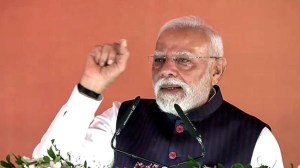When US homes put Saddam on mat, they play by the rules
On TV they have been watching Marines move into Baghdad, but at home they have been charting their own attack, complete with cluster bombs. ...

On TV they have been watching Marines move into Baghdad, but at home they have been charting their own attack, complete with cluster bombs. They are America’s war buffs, breaking out their war boardgames Back to Iraq 3 and Gulf Strike. Lending support are several ‘‘allied forces, a larger Iraqi base and a portrait of Saddam Hussein.’’
For these war buffs though, these are not just games. This is serious sport, right up there with football’s Super Bowl and Friday night NBA games. ‘‘This is serious stuff. You can’t fool around,’’ says player Chris Tucker who devours news, war updates to plan his game better. But playing the game does not signal an immediate endorsement for the war.
Long time player and designer Ted Raicer, a Bronx resident, is an active anti-war protestor. ‘‘Most of us are either war buffs or consider ourselves amateur history experts.’’
‘‘Till date the most popular games remain World War I and II and the American Civil War. Most people like to re-write old wars,’’ says Raicer. He has just completed designing a virtual boardgame for the Iraq war. In Raicer’s game, the United States Army starts off with negative points because it does not have international backing for the war. As the game proceeds, a player for the United States loses a point for every civilian killed.
The game also provides the user the opportunity of a ceasefire. Because the situation is very tough for the US military, Raicer gives players the option to change the administration in the White House.
But these rules have come in for criticism. A gamer in Consimworld’s message board wrote, ‘‘Raicer is an enemy just like Saddam.’’
Another popular computer war game that has been designed since the war broke out is Electronic Arts Inc Command & Conquer: Generals.
The game has a US strike force of jets and fighter planes pushing itself into Baghdad, but meeting with resistance from the Iraqi suicide squad and biological weapons. It stimulates modern US weaponry and presents 3D images of Iraq’s urban landscape.
War boardgames first became popular in America in the 1950s. Since then probably 1,000 war games have been designed.
The loading of these games on the Internet has brought it more mass appeal, leading it away from its selective audience.
Some war buffs still like to play the game by hand and most of them get together at Compleat Strategist, a game store in Manhattan, to discuss and play the game.
Every Friday, a group of regulars get together and pull out Gulf Strike, a game with over 50 pages of rules. Danny, a regular at the store, keeps a close watch over the movements of the US convoy and charts the course on a large map of the region for his peers at the store. The small intimate group of 10 people then work on the American Army’s next course of action.
‘‘We need to take quick and decisive action against Saddam,’’ says Danny. Buying into the Bush administration’s theory that Saddam might have had a hand in the 9/11 terrorist attacks, the native New Yorker says, ‘‘I had friends who died in the September 11 terrorist attack. New York has changed since the incident.’’
Toy makers too are hoping to cash in on the war images. Manufacturers of the GI Joe have already expressed interest in bringing out new models of their GI in battle gear for Christmas. And they are interested in equipping him with chemical protection suits.





- 01
- 02
- 03
- 04
- 05


























